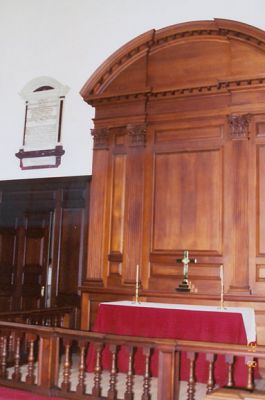One chapel altar, minus one cross
 This may sound like a strange question, but I think it is one that needs to be asked and, if asked, it could add some needed depth to a hot-button story in Virginia higher education. Ready? Why does anyone think that there should be a cross on the altar of the nondenominational, multi-faith Wren Chapel at the College of William & Mary?
This may sound like a strange question, but I think it is one that needs to be asked and, if asked, it could add some needed depth to a hot-button story in Virginia higher education. Ready? Why does anyone think that there should be a cross on the altar of the nondenominational, multi-faith Wren Chapel at the College of William & Mary?
I realize that this is an emotional issue for many people, including alumni, donors, parents and a few students. I know that this 313-year-old school was founded as an Anglican institution (and I will avoid any cheap jokes about the role of the cross in modern debates between Episcopalians and Anglicans). But the fact is that -- whatever its heritage -- William & Mary is now a public school. It's a state school.
Unless the school has other chapels available for members of other faiths, what is the church-state argument (other than historical) for a state school to have a Christian cross in its multi-faith chapel? After a quick run through the school's website, I cannot find evidence of other chapels.
I raise this because of a page-one story by reporter Natasha Altamirano in the The Washington Times, under the headline "Bow to diversity leaves altar empty." The hook for the story is the tense atmosphere at the back-to-school State of the College address by President Gene R. Nichol. Here is a key part of the story:
"I modified the way in which the cross is displayed in the ancient Wren Chapel seeking to assure that the marvelous Wren -- so central to the life of the college -- be equally open and welcoming to all," Mr. Nichol told roughly 400 students, alumni and faculty packed into the college's Commonwealth Auditorium.
Mr. Nichol said the decision has received wide support but "many, many have seen it otherwise" and have asked him to reconsider.
. . . Mr. Nichol said removing the cross has raised broader questions: "Does the separation of church and state at public universities seek a bleaching of the importance and influence of faith and religious thought from our discourse?" and "Can a public university honor and celebrate a particular religious heritage while remaining equally welcoming to those of all faiths?"
The old policy at the college was that the 2-foot-high, century-old bronze cross stayed on the altar unless someone requested that it be removed for a special event. Now, that policy has been flipped. Those using the chapel can request that the cross be taken out of storage and returned to its place on the altar.
Before, the bare altar was optional. Now, the cross is optional at William & Mary.
Some people are upset by the symbolism of the change. I am asking about the legal reality. Why have a cross in a multi-faith, state-funded chapel?
If parents, students and donors are upset, they should support private schools where the presence of the cross is normative. That is their choice. It would be interesting to ask if any William & Mary supporters are planning to do that. Can Nichol please both sides?
However, if the opponents of this move have arguments that are deeper than symbolism and tradition, I would be interested in reading them. I hope reporters at the Times and elsewhere will ask that question.